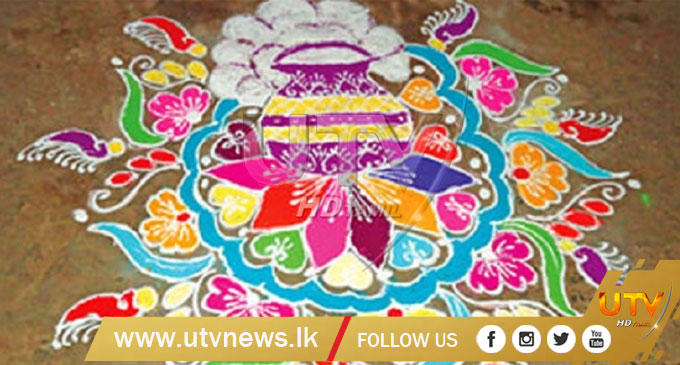(UTV|COLOMBO) – Hindus in Sri Lanka celebrate ‘Thai Pongal Day’ – culturally and traditionally the festival of harvests, on January 15. Some celebrate Thai Pongal for two or three days, depending on whether they are farmers, business people or those engaged in other trades.
The Hindus of the North and East celebrate the festival with much hope of materialising their dreams and aspirations as the spirit of the festival calls for. The plantation community celebrate the festival amidst challenges, with belief in the saying that ‘Thai Pirandhal Vazhi Pirakkum’, i.e. a way will be found when the month of ‘Thai’ dawns.Thai Pongal is basically a festival of harvest, celebrated from the ancient millennia to thank the elements of nature and give offerings to the ‘Sun God’ and cattle.
The main festival is held with offerings to the ‘Sun God’. It is mainly the festival of farmers who depend on mother earth, the sun, rain, other natural elements, and the cows and buffaloes for a bountiful harvest of their staple food, rice. It is a time when the poor, the rich, the villager and the city dweller offer thanks to the gods, worship the sun, the earth, the cattle and their bounty with devotion. Hindus acknowledge the sacredness of Earth and all life. For them, nature is a creative force worthy of respect and veneration.
Each year at harvest time, agrarian communities all over India celebrate this festival with an enthusiastic abandon. Harvest festivals occur around this time, in different parts of India and each region celebrates it differently – Thai Pongal in Tamil Nadu and Maha Sankranti in Maharashtra.
There is also Uttarayan (Gujarat) and Lori (Punjab). It is a joyous time. People dance, fly kites, sing and exchange gifts at a grand thanksgiving celebration. Makara Sankranti is celebrated throughout India on three or four days of giving thanks to four great forces of influence and protection: Indra, the giver of rain; Surya, the Sun; gracious cattle and beloved ancestors. This happy occasion is known as Pongal by Tamils, Sankranti in Karnataka, Pedha Panduga among the Telugus and Lohri by the Punjabis.
It begins on the day the sun enters Makara (Capricorn), between January 13 and 15. This is the beginning of the Tamil month of Thai, and the sun turns from the South towards the North, known as Utharaayanam, indicating the end of winter and the beginning of spring. Thai is the luckiest month in the whole Hindu calendar. It is truly an auspicious month.
Spring expresses itself with green grass, fragrant flowers and sweet fruits to be enjoyed by all. This is the only festival based on the solar system in the Hindu calendar that falls on a fixed date according to the English calendar. All other Hindu festivals follow the lunar calendar.
The name of the festival is derived from the rice dish pongal or shakkarai pongal, prepared with freshly harvested rice, milk and jaggery. Pongal means overflowing, and gives a sense of abundance.This is a special time of giving pumpkins, sugarcane and other items to the poor. Married women are honoured, and gifts are given to newborn children. Traditionally, people take a bath in any holy river. For a fortnight after this festival, women often get together and share sweets made with sesame seeds and jaggery, to symbolise friendship.A special feature is the preparation of laddus – sweet balls made with sesame, jaggery and coconut. Giving of betel leaves, nuts, flowers, fruit and homemade sugar dolls on Sankranti day is customary.
The great kite festival is held in the celebrations of Sankranti and Uttarayan. Tourists from all over the country witness the kite markets and the kite flying experts who use changes in the wind direction to enjoy this unique sport. The first day is called ‘Bhogi Pandigai ‘and is the day before the actual celebratory day of Pongal. This day marks the end of winter, which is mainly a family festival. Many people get rid of old household items and clothes and purchase new ones on this day.Houses are cleaned and painted, and rangoli drawn to decorate the entrance of homes.
A symbolic picture of the Sun is drawn. Clothes are all washed and dried. This marks the start of a new cycle and symbolises the mind also being cleaned of bad habits. New earthen pots are placed on the wooden hearth in the courtyard outside the house.
The second day is Perum, also known as Surya Pongal, and is the most important day of Pongal. Many people worship the Sun God, Lord Surya, offering prayers. Rice is then symbolically offered to the sun god along with other oblations.
Mattu Pongal is the third day and includes worshipping cattle because it is believed that cattle contribute to a bountiful harvest.
The rice is then symbolically offered to the sun-god along with other oblations. Everyone wears traditional dress and markings.
The offerings include the two sticks of sugar-cane in the background and coconut and bananas in the dish. Other offerings include grains, vegetables and fruits. This is in recognition of the importance of cattle to the agrarian community.
They are also regarded as sacred animals. The cows are given a bath and a thorough scrub.
They are then adorned and decorated with garlands around their necks and kumkum on their horns and foreheads. They are not given any work on that day and are allowed to graze without much restraint. Ceremonial boiled rice is offered with sweets and sugar cane.
The fourth day is called Kanum or Kani Pongal, which is when many people go on picnic and spend time with families and friends. The Pongal festival also includes exchanging gifts, dancing, and buffalo-taming contests. Single women seeking good husbands observe this day.
In Tamil communities, the moment the pot boils over, all shout, “Pongalo Pongal!” (“It’s boiling over!”). They watch to see whether the froth overflows toward the East, which auspiciously indicates abundance for the year ahead. Conch shells are sounded and children dance for joy.A portion of the boiled rice, the season’s first food, is offered to Mother Earth as a gesture of gratitude, and to all creatures and nature Spirits. The remainder is eaten by the families.
Courtesy : news.lk

